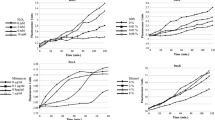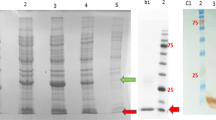Abstract
Mammalian expression vectors are used to overexpress genes of interest in mammalian cells. High temperature requirement protein A1 (HtrA1), used as a specific target, was expressed from the pHA-M-HtrA1 plasmid in HEK293T cells, inducing cell death. Expression of HtrA1 was driven by the pHA-M-HtrA1 mammalian expression vector in E. coli resulting in growth suppression of E. coli in an HtrA1 serine protease-dependent manner. By using various combinations of promoters, target genes and N-terminal tags, the T7 promoter and N-terminal HA tag in the mammalian expression vector were shown to be responsible for expression of target genes in E. coli. Thus the pHA-M-HtrA1 plasmid can be used as a novel, rapid pre-test system for expression and cytotoxicity of the specific target gene in E. coli before assessing its functions in mammalian cells.




Similar content being viewed by others
References
Chien J, Staub J, Hu SI, Erickson-Johnson MR, Couch FJ, Smith DI, Crowl RM, Kaufmann SH, Shridhar V (2004) A candidate tumor suppressor HtrA1 is downregulated in ovarian cancer. Oncogene 23(8):1636–1644
Chien J, Aletti G, Baldi A, Catalano V, Muretto P, Keeney GL, Kalli KR, Staub J, Ehrmann M, Cliby WA, Lee YK, Bible KC, Hartmann LC, Kaufmann SH, Shridhar V (2006) Serine protease HtrA1 modulates chemotherapy-induced cytotoxicity. J Clin Invest 116(7):1994–2004
Clausen T, Kaiser M, Huber R, Ehrmann M (2011) HTRA proteases: regulated proteolysis in protein quality control. Nat Rev Mol Cell Biol 12(3):152–162
Hou J, Clemmons DR, Smeekens S (2005) Expression and characterization of a serine protease that preferentially cleaves insulin-like growth factor binding protein-5. J Cell Biochem 94(3):470–484
Kim GY, Moon JM, Han JH, Kim KH, Rhim H (2011) The sCMV IE enhancer/promoter system for high-level expression and efficient functional studies of target genes in mammalian cells and zebrafish. Biotechnol Lett 33(7):1319–1326
Melton DA, Krieg PA, Rebagliati MR, Maniatis T, Zinn K, Green MR (1984) Efficient in vitro synthesis of biologically active RNA and RNA hybridization probes from plasmids containing a bacteriophage SP6 promoter. Nucleic Acids Res 12(18):7035–7056
Park HM, Kim GY, Nam MK, Seong GH, Han C, Chung KC, Kang S, Rhim H (2009) The serine protease HtrA2/Omi cleaves Parkin and irreversibly inactivates its E3 ubiquitin ligase activity. Biochem Biophys Res Commun 387(3):537–542. doi:10.1016/j.bbrc.2009.07.079
Paschal BM, McReynolds LA, Noren CJ, Nichols NM (2008) RNA polymerases. Curr Protoc Mol Biol (Chapter 3: Unit3.8)
Prosen DE, Cech CL (1986) An Escherichia coli RNA polymerase tight-binding site on T7 DNA is a weak promoter subject to substrate inhibition. Biochemistry 25(19):5378–5387
Roszak DB, Colwell RR (1987) Survival strategies of bacteria in the natural environment. Microbiol Rev 51(3):365–379
Sambrook J, Russell DW (2001) Molecular cloning: a laboratory manual, 3rd edn. Cold Spring Harbor Laboratory Press, Cold Spring Harbor
Sousa R, Mukherjee S (2003) T7 RNA polymerase. Prog Nucleic Acid Res Mol Biol 73:1–41
Studier FW, Moffatt BA (1986) Use of bacteriophage T7 RNA polymerase to direct selective high-level expression of cloned genes. J Mol Biol 189(1):113–130
Acknowledgments
This stduy was supported by the National Nuclear R&D Program through the National Research Foundation (NRF) of Korea, which is funded by the Ministry of Education, Science and Technology (MEST) (2011-0018783); and NRF Grant funded by the Korean Government MEST (2010-0029422); and a Grant of the Korea Health Technology R&D Project, Ministry of Health and Welfare, Republic of Korea (A101099).
Author information
Authors and Affiliations
Corresponding author
Additional information
J.-M. Moon and G.-Y. Kim contributed equally to this study.
Electronic supplementary material
Below is the link to the electronic supplementary material.
Rights and permissions
About this article
Cite this article
Moon, JM., Kim, GY. & Rhim, H. A new idea for simple and rapid monitoring of gene expression: requirement of nucleotide sequences encoding an N-terminal HA tag in the T7 promoter-driven expression in E. coli . Biotechnol Lett 34, 1841–1846 (2012). https://doi.org/10.1007/s10529-012-0966-8
Received:
Accepted:
Published:
Issue Date:
DOI: https://doi.org/10.1007/s10529-012-0966-8




